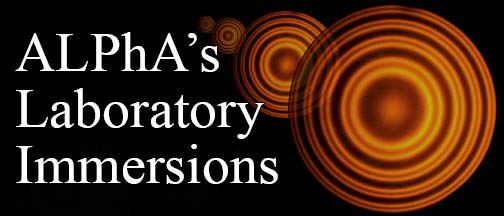- Home
- What We Do
- Laboratory Immersions
- Immersions 2018
- Imm2018Willamette_MOT
Magneto-Optical Trap
Willamette University (Salem, OR), August 8 – 10, 2018
(One set-up available) - FULL! Please register to be placed on a waitlist
Through a clever combination of red-detuned, circularly polarized light and magnetic fields, the magneto-optical trap (MOT) slows atoms from their speed at room temperature (around 1000 m/s) to just a few cm/s, all in about a milli-second! This efficient workhorse is an ideal starting point for ultracold atom/molecule experiments, Bose-Einstein Condensation, or quantum computation experiments.
Participants will work in a dedicated lab space that contains an 8’ x 4’ optics table and standard optics equipment. ColdQuanta has agreed to lend us a vacuum chamber with rubidium dispensers and the required polarization optics for this immersion, and Vescent Lasers will provide two diode lasers at 780 nm that will be used as trap and repump laser for the MOT.
The MOT has become a reliable workhorse for many ultracold atom and molecule experiments. Much of current AMO work begins with atoms cooled and trapped in a MOT. While the temperatures obtainable in a MOT are not low enough for more sophisticated experiments like Bose-Einstein condensation, the MOT is the perfect starting point for such experiments. Current research efforts focus on multiple species trap to form ultracold or cold heteronuclear molecules, or applications in quantum computation.
This immersion will focus on providing participants with basic hands-on experience and tips & tricks on how to get the MOT to work, and as such will focus more on lab skills and less on actual experiments with ultracold atoms, which would require additional equipment and sophistication. Participants will see a working rubidium MOT in action in my research lab, and will then assemble the diode laser system and the vacuum system from scratch to trap their own first atoms. During the process, they will become familiar with the saturated absorption profile of rubidium and learn how to use it to generate the required frequencies to “talk” to and successfully trap the atoms. They will observe the fluorescence in the vacuum chamber and learn how to see if, for example, the polarization of the lasers is incorrect or if the magnetic field is too strong or too weak.
After a laser safety training, we will spend most of the first day in my lab or in a classroom to familiarize all participants with the underlying physics and the required optics equipment. In my lab, I will demonstrate how the fluorescence in the vacuum chamber is affected by e.g. incorrectly chosen polarization, power imbalance, magnetic field, etc., and we will look at some basic optics equipment and learn how it affects a laser beam. On the second day, participants will move into the dedicated lab space and begin assembling their laser and vacuum system. Participants will work together on this since there is one setup for all participants. This setup will be completed by the end of the second or the beginning of the third day. The third day will be spent “playing” with the trapped atoms to gain more familiarity with how sensitive the trap depends on various trap parameters.
Participants should bring anything that allows them to take notes efficiently and effectively (laptop, notebook, paper, pen, e-paper,…). Participants may also take photos or videos in the lab. Electronics and other equipment, as well as safety goggles, will be provided.
We will work with lasers, so safety goggles must be worn to protect the eyes (I will provide them to all participants). These lasers are not powerful enough to cause damage to the skin or pose a flame hazard. Participants will receive the appropriate safety training at the beginning of the immersion.
A rough estimate of the cost of the apparatus would be between $20k and $30k. This includes the vacuum chamber, pumps, lasers, and optics. The cost can be reduced by opting for home-build systems and controllers.

I (Michaela Kleinert) received my German “Diplom” (roughly equivalent to the American Master’s) from the University of Heidelberg and the Max-Planck Institute for Nuclear Physics in 2002. During my time in Heidelberg, I worked on designing, assembling, and testing a highly compact rubidium magneto-optical trap to be used in Rb Rydberg experiments. I continued my ultracold education in Nick Bigelow’s group at the University of Rochester, where I trapped rubidium, cesium, and potassium in individual traps near a reflective surface (“atom chip”) and studied their interactions. I received my PhD in AMO physics from the University of Rochester in 2008 and was hired as assistant professor of physics by Willamette University where I’ve been every since. At Willamette, I maintain two extensive research projects with all-undergraduate research assistants (I currently have 13 students in my research group). One project focuses on atom cooling and trapping of rubidium and calcium, and the other project focuses on laser ablation studies to create nanoparticles and hydrophobic surfaces.
Michaela Kleinert, Associate Professor of Physics, Willamette University, Physics Department, 900 State Street, Salem, OR 97301.
Email: mkleiner@willamette.edu. Phone: 503-370-6338.






